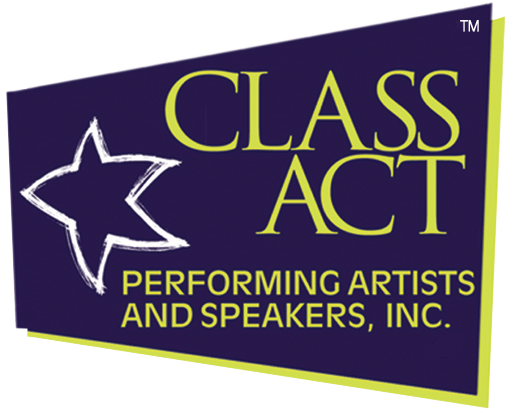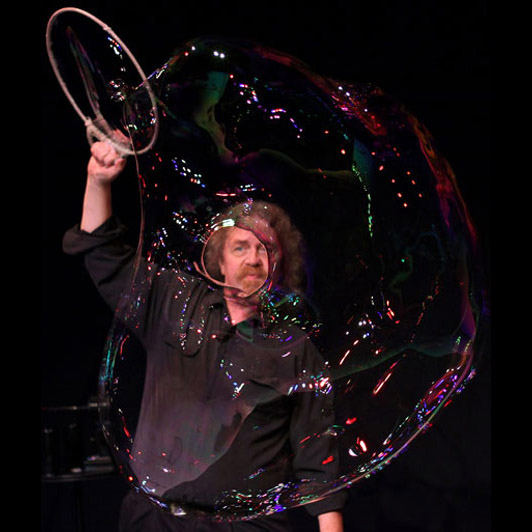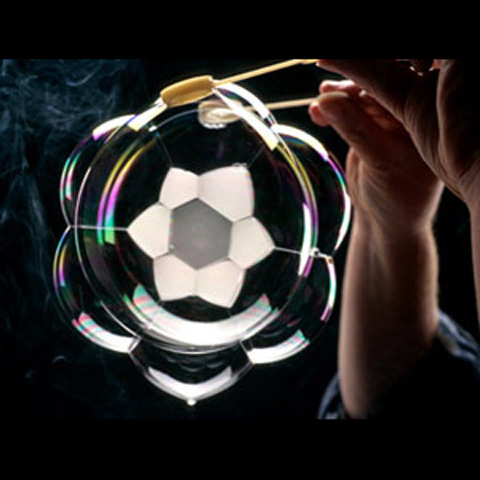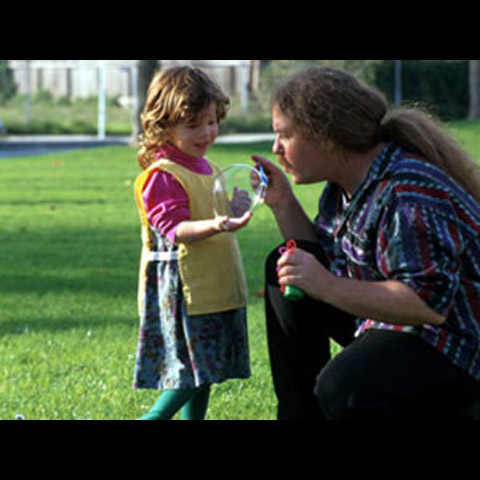Contact Us
Call Us: (800) 808-0917
Mon-Fri: 9:00 am – 5:00 pm CST
Send us an email
Links
Categories
About Class Act





Before first bringing his performance to television in the early 80s, Tom Noddy spent over a decade developing a new kind of performance piece. Sitting alone with dime store bubble solution, a childlike sense of wonder and an adult sense of humor he brought a new thing into being: Bubble Magic.
After three appearances on The Tonight Show, Tom was featured on the Best of the Year Tonight Show segment. In his 20-plus-year career as America's Bubble Guy he has appeared on numerous prime time television shows as well as night clubs and universities. Tom's work has been presented to 900 mathematicians at the International Congress of Mathematics in Berlin, Germany. He has been the featured performer for science center Bubble Festivals attracting up to seventeen thousand people in a single weekend. He is as comfortable performing for pre-schoolers as he is when entertaining audiences in the variete theaters of Germany, the Paris Opera, Le Casino nightclub in Monte Carlo, corporate parties, trade shows, or television throughout the world.
Tom has taken his uniquely warm and charming sense of wonder and delight in soap bubbles to audiences around the world. The bubbles are truly exquisite and Tom's lively humor and engaging sense of fun leave his audiences both delighted and intrigued.
Tom's Bubble Magic has been presented on television shows all over the world...Universities, Physics and mathematics conferences, Variete theaters, Science and Discovery Centers, Nightclubs, Corporate Events and Galas, Other Entertainment and Education Venues
TELEVISION APPEARANCES
USA: The Tonight Show 3 times, Tracy Ullman, Show, That's Incredible, NBC and CBS national news morning shows, noon shows, and evening news shows in over 50 American cities
Germany: mit Rudi Carrell, Knoff Hoff Show
France: avec Sabastien, Jacques Martin
Portugal: Luis de Matos
U.K.: Paul Daniels
THEATER APPEARANCES
Wintergarten, Berlin
Chamaeleon, Berlin
Star Club, Kassel,
Roland Frosch, Muenster
GOP, Hannover
le Cabaret, Monte Carlo, Monaco
International Congress of Mathematics, 1998, Berlin, Germany
"He makes science fun, beautiful fun." - San Francisco Chronicle
"You won't believe your eyes."- New York Times
"Delightful fellow ... exquisite bubbles."- Los Angeles Times
"Tom's Bubble Magic presentation was the centerpiece of our first BubbleFest and drew huge and new audiences to our Museum." - Kathleen Conti, Public Programs Manager, Santa Barbara Museum Natural History
Soap Bubbles are so pure and simple, it's only natural that kids, physisists and mathematicians are their biggest fans.
I understand a bit about the "Plateau Problems" and other reasons why bubbles have been of interest to mathematicians from Isaac Newton to present day scientists working with super computers but the truth is that I know more about the physics of bubbles than about the mathematics.
In fact, mathematicians fascinate me partly because I do not understand them. The language of math is foreign to me; the written form of the language, equations, is a language written in an unfamiliar alphabet. But hearing mathematicians speak about bubbles has led me to some wonderfully abstract thinking. As Alice said in Through the Looking Glass when she read the nonsense poem Jabberwocky "It seems very pretty but it is rather hard to understand! Somehow it seems to fill my head with ideas--only I don't know what they are!"
"My grandfather talked continuously about soap bubbles, and of course in mathematical terms. I did not understand a word of what he said. —Bernhard Caesar Einstein, the grandson of Albert Einstein
If you look closely at the suds in the sink the next time you are doing the dishes you'll be tempted, at first, to agree that this is a good example of the chaos of nature.
There are so many different shapes to the cells...pyramids, boxes, mulitsided irregular shapes all stuck together. Look closer...
Bubble walls always join three walls along an edge at three equal 120° angles. The edges always join four edges at a point, the angle there is always 109° 28' 14".
That apparent chaos is, in fact, a network that is demonstrating nature's insistence on minimal forms. Nature is always minimizing but rarely do we see so perfect an example of that tendency as we do when we look at a soap bubble ... or a cluster of soap bubbles.
Trees branch following these same minimizing principles but trees are complex living structures that are working to balance several conflicting needs: spreading out a leaf to gather sunlight, sending down roots toward moisture, carrying nutrient throughout the large system ... Look closely and you will notice that the tree branches always join in three way junctions, so do the roots, so do the veins within the leaves ... this is a minimal way of networking and nature always minimizes.
The same is true when you look at star clusters or the patterns made by sections of a tortoise shell or the scales on a fish or the packing of grains of sand on a beach ... the principles are those of minimal energy ... but they are more difficult to discern until you know the many forces at work.
In the case of a soap bubble there is really only one force at work ... the minimizing effects of surface tension on these nearly weightless fluid forms. The films are, for the most part, thinner than wavelengths of light (!). There is hardly any mass, therefore, hardly any distorting effects of gravity in choosing what shapes are assumed. There is no life force acting to gather nutrition or to spread out in the sun. They are only trying to minimize and they are fluid so they can keep moving until they find THE minimal shapes.
A single soap bubble in the air is a nearly perfect sphere. The reason for this is the same reason that planets are spheres, or stars ... A single force (gravity for the planet and star, the electrical attractions that appear as surface tension for the bubble) is acting to minimize the form of the object. A sphere is the most economical shape in nature, it uses the least amount of surface area to contain a given volume.
If a bubble were any other shape (it is often oval while being blown) it will keep moving until it finds a spherical shape ... and once it does, it stops adjusting its shape ... it has arrived at the minimal and only there will it stabilize.
When two or more bubbles touch they act to share a common wall, thereby saving material for both. But they don't just settle for any arrangement where their edges join. They are fluid, they keep moving until they find the minimal arrangement and that is ... three walls along an edge joined at 120°, four edges at a point at 109° 28' 14" ... if there were a more economical way to join they would join in that way ... there isn't.
Bubbles have fascinated physicists and mathematicians for centuries. Sir Isaac Newton made his own bubble formulas, others preceded and followed him in efforts to understand their nature. One of the most useful ways that they have served science is in showing minimal areas when applied tovarious geometric frames. Oddly, there is no good mathematics for solving these very basic questions.
If you were to take a ring or hoop and ask what shape would be necessary to fill the space within the round ring ... you may intuitively guess at a flat round disc. Any hills or valleys within that disc would cause the form to have extra surface not needed to fill the ring. If you were to dip that ring or hoop into soapy water you would get a film that is a flat round disc.
Now, suppose that you bent the ring here and there into some oddly curvy shape (but still closed like a ring). Now what is the minimal shape needed to fill that new wavy ring? We don't know ... and there is no mathematics to help you settle the question.
This is part of an old mathematics puzzle called the Plateau Problems. Plateau, a Belgian physicists asked questions like these in the 1880s and many of his questions are still unanswered. It is known that if you dip that wavy ring into soapy water you would pick up a film that is the most minimal shape possible ... soap films must minimize, they have no choice.
An architect named Otto Frei used this principle to design some beautiful buildings using the soap films ability to show him minima. He was therefore able to construct buildings that did not need extra pillars or other help to hold up the walls or ceiling because he knew that he was using the most minimal shapes for the construction of his light weight materials. He knew it was the most minimal because he tested it with soap films ... mathematics alone was not enough, he needed the soap bubbles.
Space Chronicles #8
NASA website article by: ISS Science Officer Don Pettit
In early 2003 Science Officer Pettit, an astronaut aboard the International Space Station, prepared to experiment with soap bubbles in space. As you will read in the text, he was distracted from that experiment when he was surprised to find that he could produce a durable film with pure water. This was an unanticipated new bit of science. Water films on the Earth's surface have difficulty forming and are not at all durable. Many (including me) have assumed that this was the result of the pull of the surface tension combined with the ready evaporation of the water when it is unprotected by the layer of soap at the surface. Now we can see that the pull of gravity played an even bigger role in destroying the pure water film whenever it did form (think of the temporary water bubbles that form and collapse when you run water into your sink or bathtub). In zero gravity (0g) that force plays no part and the surprisingly thick water films can deal with the effects of evaporation for a long time (though it does not appear that film formed into pure water bubbles were nearly as long-lasting). It seems as though that nature has a few more surprises up her sleeve and it's a good idea to keep our eyes open even (or especially) when looking at phenomena that we believe we already understand.
Upon seeing Bubble Magic in a nightclub or other grown-up venue, people will often exclaim, "oh, but the kids must LOVE this."
And, of course, children do love bubbles. But my skill with bubbles is less surprising to them … they hadn't spent so many years assuming that a bubble cube would be impossible. They can imagine bubbles the shape of a donut or bubbles that float straight up or bubbles within bubbles within bubbles or …
When grown-ups see these things they seem to be witnessing an overthrow of established laws. The effect is often one that frees their imagination. For kids there is seldom an imagination that is less than free.
Over the years I have had to change from one formula to another. I developed Bubble Magic using Wonder Bubbles from a company called ChemToy. A larger toy corporation called Strombecker bought up ChemToy and renamed Wonder Bubbles as Mr. Bubbles (not to be confused with Mr. Bubble, the bubble bath product). That was the same good stuff and it was cheap and available for years and years at Woolworth in America. Now Strombecker has gone out of business (so has the American Woolworth). By then I had discovered that I could do my show with Pustefix, a German product from a nice family company (I would modify their excellent bubble solution with dish soap to make it act a bit more like the Mr. Bubbles that I'm use to).
Now there is a newer product on the shelves called Gazillion Bubbles that works good so I sometimes use it, sometimes I will use Pustefix and sometimes I'll mix dish soap and water and add a bit of this or that to make it stretch better
When mixing at home (usually better for very big bubbles) I will mix some dishwashing liquid with water and maybe add some of the commercial bubble solutions sold in the shops or a little glycerin (sold in drug stores/pharmacies.
Try the following mixture of homemade Bubble Juice:
1 part dish soap (I'm having the best luck with blue Dawn nowadays)
16 parts water
8 parts commercial bubble liquid or a MUCH smaller amount of glycerin or corn syrup (start with a teaspoon and mix thoroughly before adding more … don't over do it).
Stir it well but try not to make a lot of suds while mixing, if you do, scoop the suds off of the surface. Suds is the enemy of bubble making and having a bucket around to periodically scoop it into will improve the bubble blowing a lot.
This is the one bubble activity that I like the best for kids. Bubble domes are very stable and it's a lot easier to manipulate them. Blowing bubbles through a straw allows you to fix the size more carefully ... too big? suck some air out of it, not big enough? put the straw in and then a quick suck to break the film within the straw and blow to add more air and increase the size of the bubble.
This can be messy but that can be minimized with some care beforehand but in either case, put down a rug or non-slippery mat or just newspapers around the play area.
A level table helps and consider creating a rim on the edge of the table (a simple one can be made with duct tape and imagination).
I suggest that you put the liquid into a doggie bowl or one of those Tupperware-like tubs that people sometimes use to wash their dishes in ... something stable that will not be easily spilled. In either case, don't just hand out jars of liquid to playing children that encourage them to go mobile with the liquid ... if you do, and they spill it ... well, that wasn't their fault. You'd spill it too if you'd play.
You'll need:
* A table
* Plastic drinking straws
* Bubble mix (see above) in a stable container (doggie bowl or dishwashing tub)
* Bubble liquid container. My favorite is a doggy bowl or other stable container for the liquid, not a normal bubble jar.
1.Wet a part of the tabletop
2. Dip the straw deep into the bubble mix
3. Now blow bubble domes onto the wet surface.
You can make a long chain of bubbles attached one behind the other (caterpillar), bubble domes within bubble domes (make sure that a lot of the straw is wet, any dry part will break the outer bubble), groups of bubbles together (six bubbles around a center bubble will show you a hexagon, five around will show you a pentagon ...) bubble towers, ...
You can't blow an ugly bubble so why not just jump in and give it a try?
For this you will need:
* Plastic drinking straws
* Cotton string cut to various lengths
* A bucket or tub of the bubble liquid
* Paper towels for drying hands afterwards
1. Thread a length of string (minimum of about 30 inches / 75 centimeters or ... about four times the length of the drinking straw) through the two drinking straws
2. Tie the ends of the string into a knot. The straws then become the handles for this simple and excellent bubble-blowing tool.
3. Hold one of the straws in each hand and immerse your hands into Bubble Juice. Keep your fists together as you take them out of the liquid and once you are out in the air with them, spread them apart to expose the large soap film to the air.
4. NOW pull this through the air to produce very big bubbles!
* Hint for success: Pull, don't push ... if you push, the bubble will emerge directly in front of your body and it'll pop on you.
* Hint for success: Read #3 above again. Pulling the film up out of bucket and perhaps into a wind can be a tricky part of this ... the film might snap while emerging. Keeping your hands together will ensure that there is no vulnerable film until you're ready to wave out the bubble
* Hint for success: To close the bubble simply put your hands (therefore, the straws) together again. The film will close off by itself.
* One more hint: When cleaning up afterwards, add some vinegar to the cleaning water. This will destroy the frothing ability of the soapy water and eliminate all the trouble with foam while cleaning.
